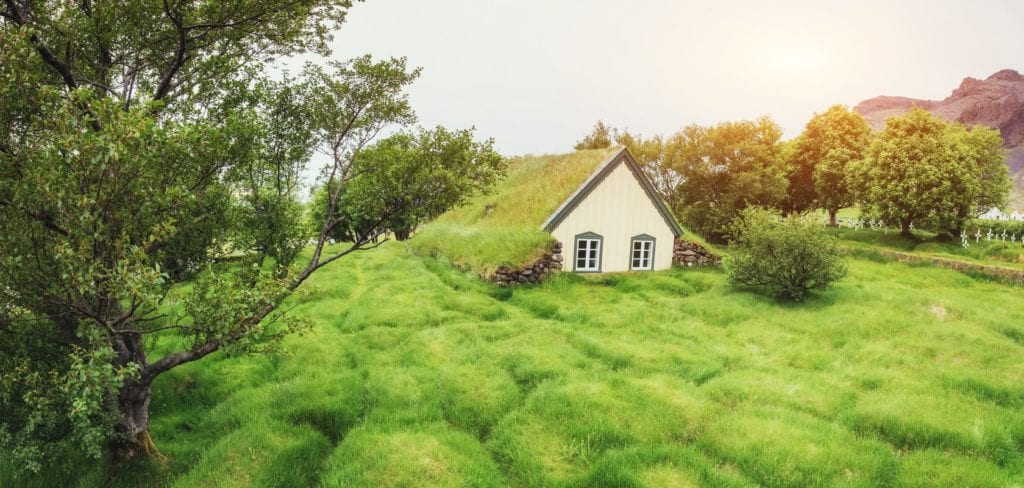Although the famous Hallgrímskirkja is a magnificent building, it gives a false impression of Iceland and its churches, many of which are far more beautiful in their simplicity and richer in history.
Hobbit churches
For a bit of context regarding Icelandic churches, one must bear in mind that this small and isolated island nation did not experience the architectural waves and fashions of the medieval period that dominate the landscape of Europe. Most church builders there did not have to take into account possible lava eruptions; factor this variable in along with a lack of physical resources and capital in general, which was also a hindrance in building extravagant churches such as the ones seen on the continent. Earthquakes, fires, volcanoes, floods, neglect and pestilence have all contributed to the degradation of many old churches. Therefore, most of the modern country churches seem like quite homely erections of corrugated iron, timber or concrete, especially in comparison to their European counterparts.
Historically, after the conversion to Christianity, churches were usually built as an integral part of the farmstead, having been constructed or commissioned by chieftains. One notable example would be the Viðimýri land, in the north of Iceland, where the local chieftain or goði (Kolbeinn Tumason) ruled. At Viðimýri, there has been a church, according to sources, from around the turn of the 11th century. The church that currently stands was built with driftwood and turf in 1834. Other such churches include Saurbær, which is not far from Viðimýri, as well as Hofskirkja which is close to Skaftafell in South Iceland. Fairly close by is Núpsstaðir which also belongs to this historical tradition of Icelandic turf churches. All of these turf churches are well worth a view.
Snæfellsnes Peninsula
Many tourists that visit Stykkishólmur go to see its rather elegant church—but, like Hallgrímskirkja, it rings a bit false with its modernity. However, one of the most striking churches in Iceland and a favorite among Icelanders, especially for weddings in Iceland is the black church at Búðir. As mentioned above, many “modern” churches stand on the sites of previous turf churches or the grounds of settlement era churches.
If you get the chance, another beautiful and picturesque, but seldom mentioned church on the Snæfells Peninsula is found at Hellnar, with Stapafell Mountain as a backdrop.
Icelandic eccentricity
Two peculiar looking churches that seem to have jumped out of the imagination of a pastel adoring Miami Vice fan are the two blue churches in Stöðvarfjörður and Seyðisfjörður. In Stöðvarfjörður there is Kirkjubær, built back in 1925. The now defunct church functions as a guesthouse. With its exterior and interior largely intact, it provides people the opportunity to spend a night in a church which serviced but a few souls at the edge of the world. Seyðisfjörður is the other famous blue church of Iceland and is known for its summer concerts in the somber but beautiful town of Seyðisfjörður.
Secluded churches
A noticeable feature of Icelandic churches is that most of those outside the capital or large municipalities are usually made of timber and their architecture, including the interior, is often very similar. In many of these churches, the interior depicts the social status of the parish, e.g. certain pews or benches were specified for landowners and more prominent farmers or officials that oversaw the district. The church Saurbæjarkirkja, located by Rauðisandur Beach is typical of such architecture. This church has a shorter history compared to the turf churches—only a few decades at its current location. While visiting you can walk on the seemingly endless beach to faraway Látrabjörg, the westernmost point of Iceland. If you have the stamina to thread through most of the West Fjords, Staðarkirkja in Steingrímsfjörður Fjord should be high on your priority list as well.
Outliers
In the north of Iceland, close to Blönduós is the famed Lake Svínavatn. South of it is one of Iceland’s more intriguing churches, Auðkúlukirkja, named after Eyvindur Auðkúla who is mentioned in The Book of Settlements. Immediately upon seeing Auðkúlukirkja, one is struck by its architecture—a mixture of a monopteral structure blended with a gazebo. However, the inspiration for the church is a mixture of the Greek Orthodox and Catholic building traditions.
The churches in Iceland are a sight to behold. If anything, it is impossible to do justice to them all and many have been left out here. Wherever you go in Iceland and whatever your religion, make sure you don’t miss out on those beauties.


